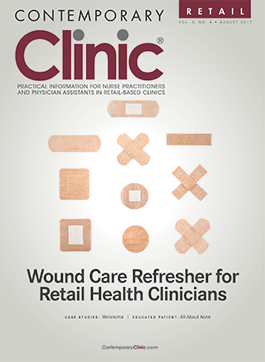Melanoma: An Overview
Melanoma is the fifth most common cancer in men and the seventh most common cancer in women and accounts for most skin cancer deaths.
Melanoma is the fifth most common cancer in men and the seventh most common cancer in women and accounts for most skin cancer deaths. The annual cost of melanoma treatment in the United States exceeds $3 billion, and about 9000 deaths each year are attributed to this form of cancer.1
Risk factors for melanoma are both genetic and environmental. About 10% of melanoma patients have a first- or second-degree relative with the disease.2Familial cases of melanoma have been linked to 2 identifiable genes. Other factors that increase the risk of melanoma include blond, light brown, or red hair. Blue eye color and a high freckle density are also indicated as risk factors. Increased numbers of nevi (birthmarks/moles) present also indicate a proportional increase in risk for melanoma.2
Skin cell damage from ultraviolet exposure is the recognized cause of more than 90% of melanoma cases.1Indoor tanning is a significant modifiable risk factor. Sun exposure should be minimized with the use of sunscreen with a sun protection factor (SPF) of 15 or higher and by seeking shade and wearing sunglasses, protective clothing, and hats. Additionally, scheduling outdoor activities early or later in the day is recommended.3
Patients should be encouraged to report any observed changes in their skin, especially new growth, changes in old growth, or skin that will not heal.4Dermoscopy, a handheld light magnifier, can aid diagnosis based on lesion appearance.An early diagnosis with excisional biopsy can improve prognosis and survival.2An acronym called the A-B-C-D-E’s of melanoma can assist in assessing an area of concern on the skin. The A is for asymmetrical, as an irregular shape can be a sign of melanoma. Border is the B, as irregular or jagged borders of moles are also more concerning. C is for color, as uneven color of the lesion may indicate the need for further evaluation. Diameter is the D, as moles or spots larger than a pea are more concerning; and E is for evolving, meaning the patient has seen changes in the past 1 to 2 months.
MELANOMA CASE STUDY
Judith Ann, a 49-year-old Caucasian female who works part-time and is in good health, presented to her primary care physician with a new-onset enlarged submandibular lymph node. She reported noticing that the node had been present for about 2 weeks and seemed to be getting larger. Judith denies fever, chills, rashes, weight gain, or recent illness. She does not smoke or drink alcohol.
DISCUSSION QUESTION: What additional information would you want to know about Judith Ann’s history and presentation?
ANSWER: Her parents are both deceased, her father from lung cancer with a tobacco history, and her mother from ovarian cancer. Her only sibling is alive and well. Physical exam findings are unremarkable, and she is up-to-date with her mammogram. She does say that she saw an ophthalmologist 2 months ago because of what she described as a sty that wouldn’t go away and had to be removed.
DISCUSSION QUESTION: What additional questions related to the removal of a lesion from her eyelid are relevant?
ANSWER: She said that she thought the lesion was asymmetrical, had changed color, and was growing. At the time of removal, it was not sent for a pathology exam. She reported not using sunscreen as a child and remembers having several severe sunburns. She has light brown hair, blue eyes, and a very light skin tone. Referral for further evaluation was made. A biopsy on the lymph node the next week was positive for melanoma. The lesion removed from Judith Ann’s eyelid was likely the primary melanoma site.
DISCUSSION QUESTION: What are the follow-up recommendations for Judith Ann?
ANSWER: After diagnosis and treatment at an oncology center, it is important to provide her with information on how to monitor for recurrence or secondary skin cancers. She should be seen at least once a year for a full skin exam and lymph node assessment. More frequent evaluation may be needed for some cases.2The use of sunscreen and sun-protective clothing, hats, and sunglasses should become part of her daily routine. Also, education on self-exams can promote early detection, improving mortality.5
SUMMARY
Health care providers need to highlight prevention. In communities, increased access to shade at public playgrounds and schools can promote sun protection. Education about the harmful effects of sun exposure, including indoor tanning, is needed. Avoiding sun exposure from 10 am to 4 pm is also recommended. Although Caucasians have a high risk of melanoma, those who are not white are also at risk for the disease. Communicating the dangers of sun exposure and the importance of wearing hats, sunglasses, protective clothing, and sunscreen with at least an SPF of 15 is vital.
Lisa Bridwell Robinson, DNP, CCRN, CNE, NP-C, is a family nurse practitioner and certified nurse educator who practices as a work site health coach. Dr. Robinson also serves as a faculty member for graduate nursing students in both master’s and doctoral programs of study. This case study is written in honor of her mother-in-law, a cherished nurse, wife, and mother who courageously battled melanoma.

